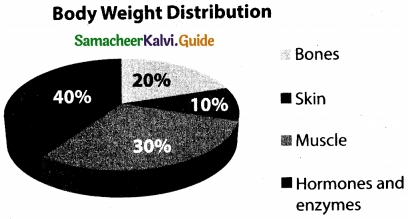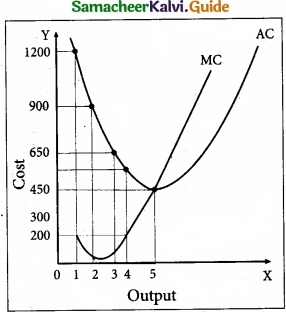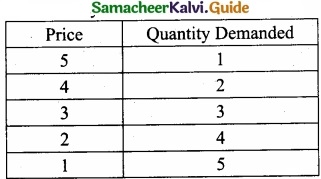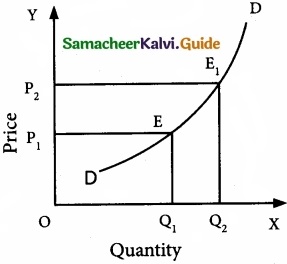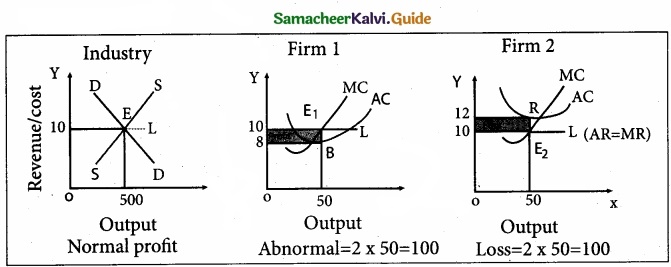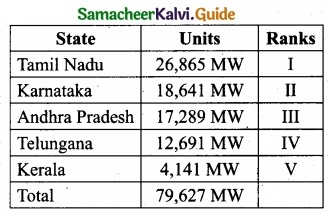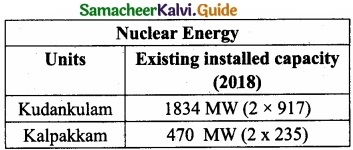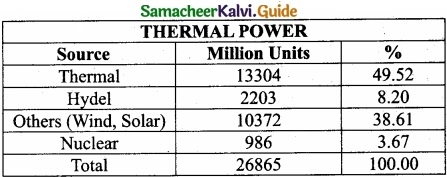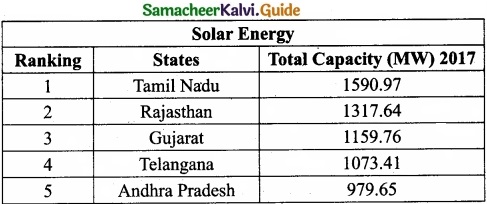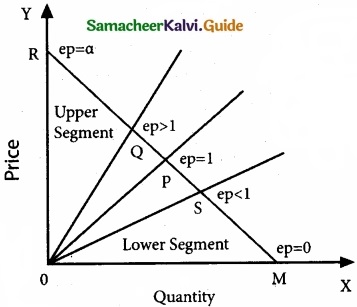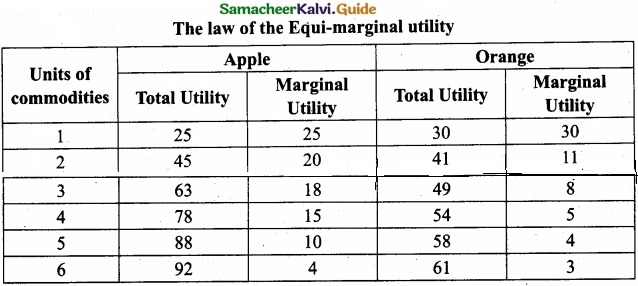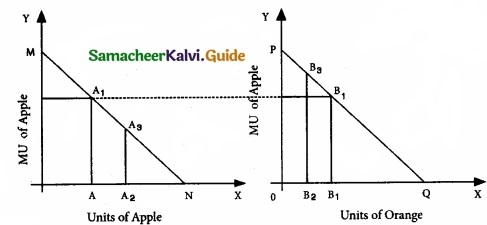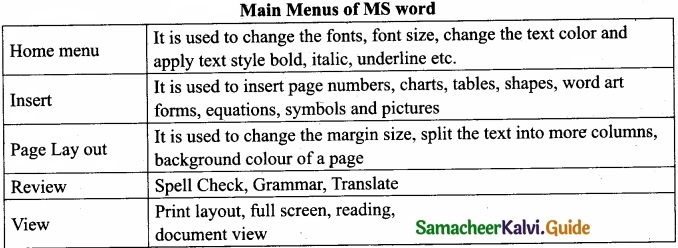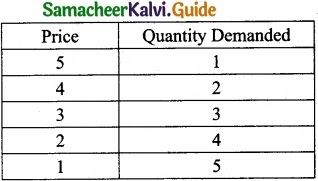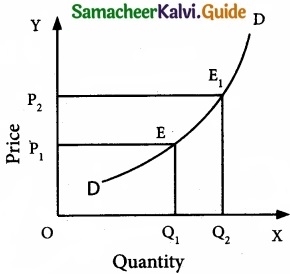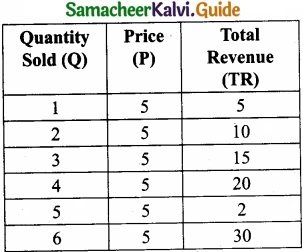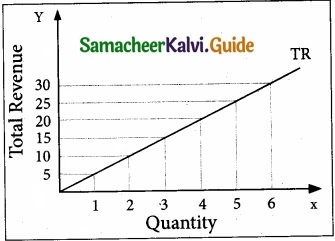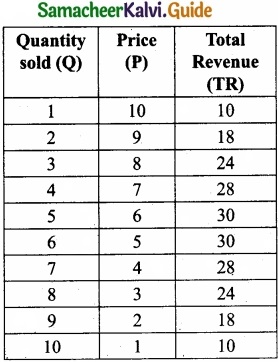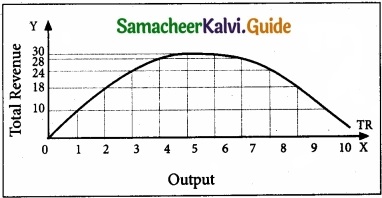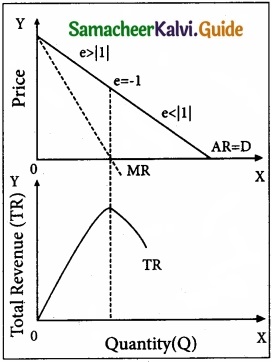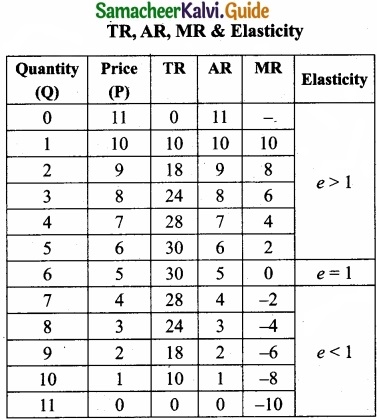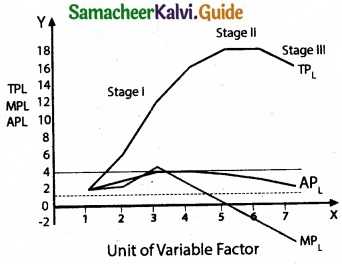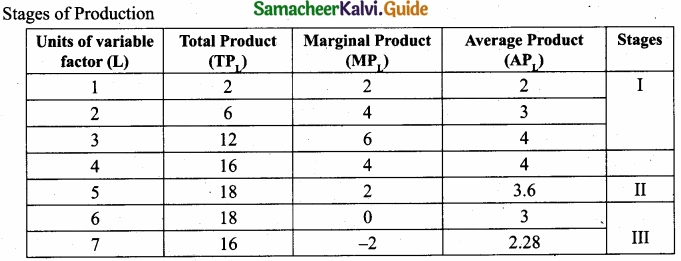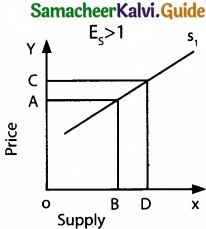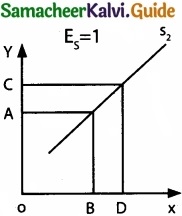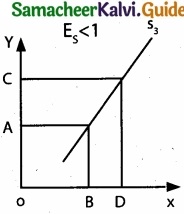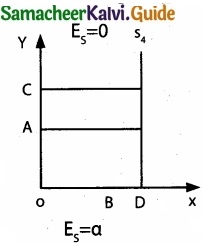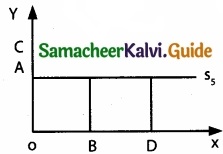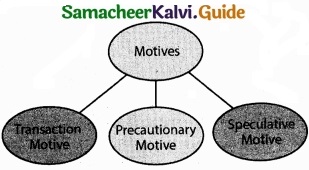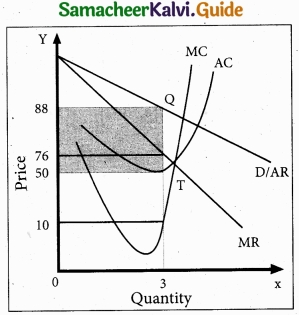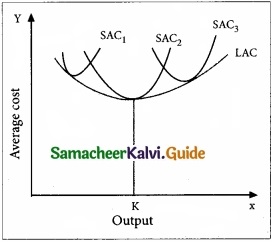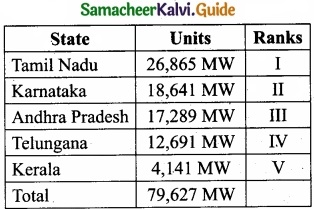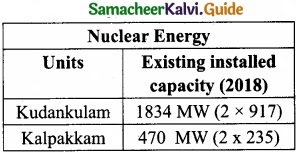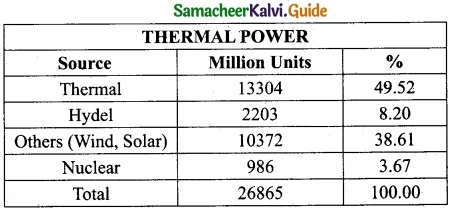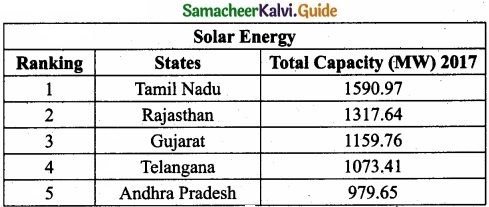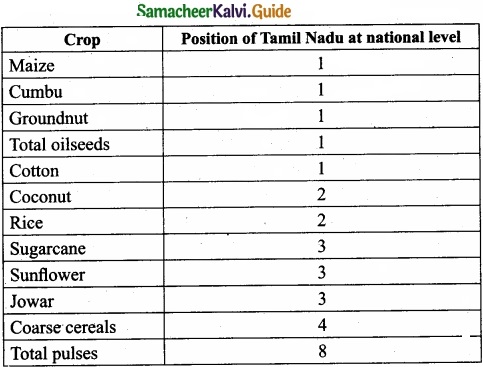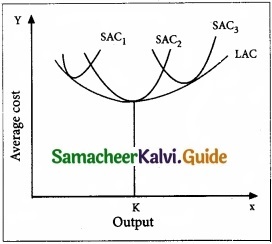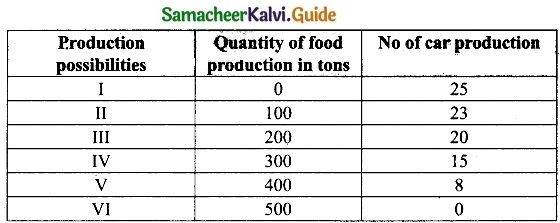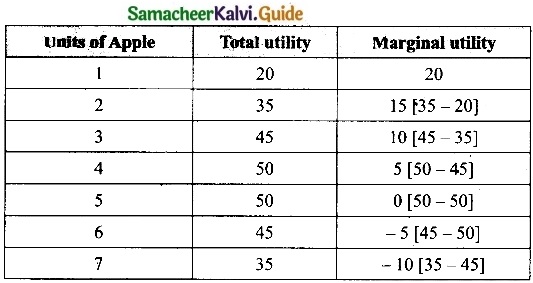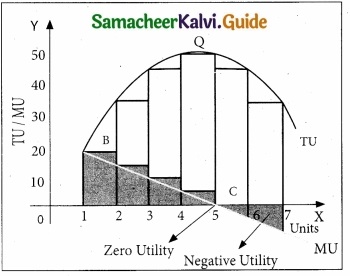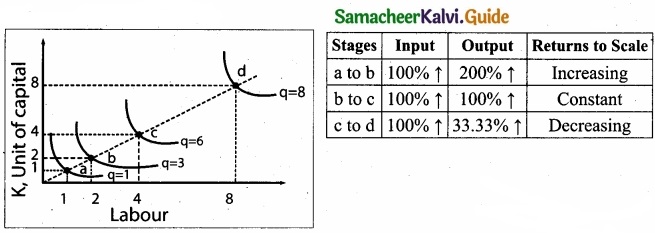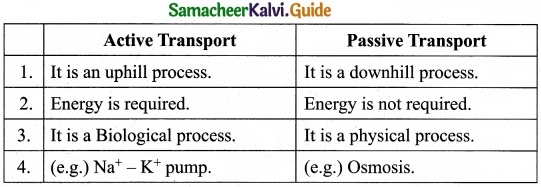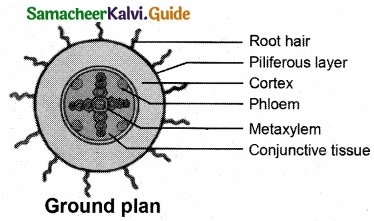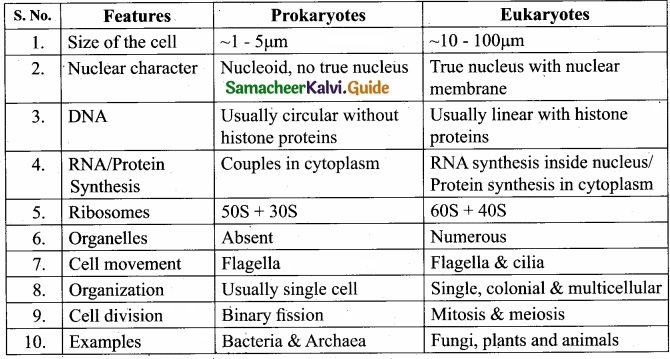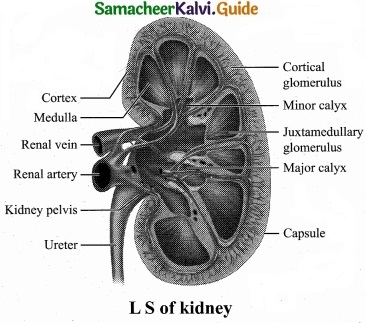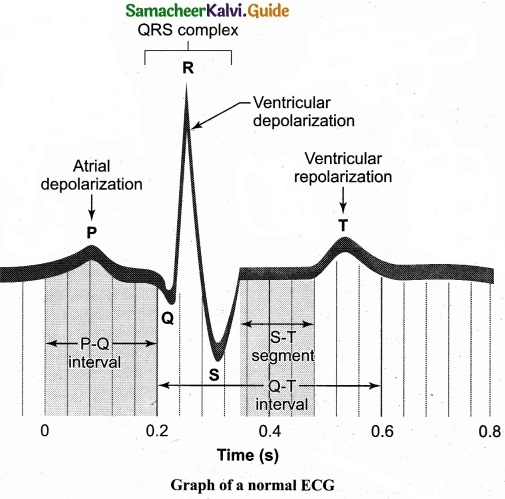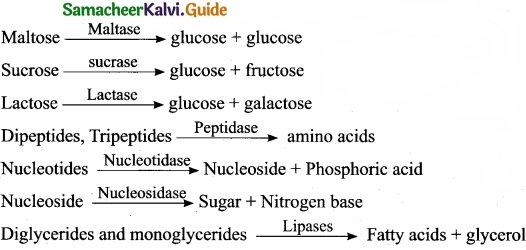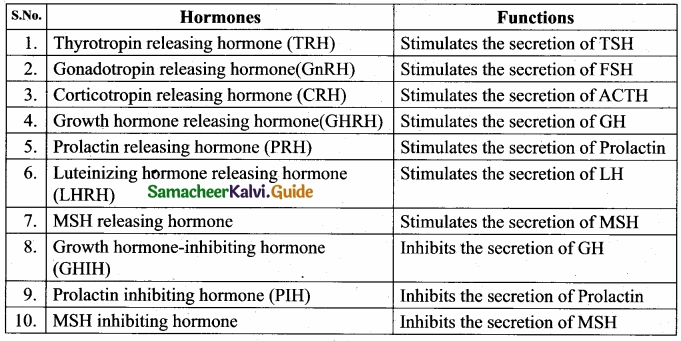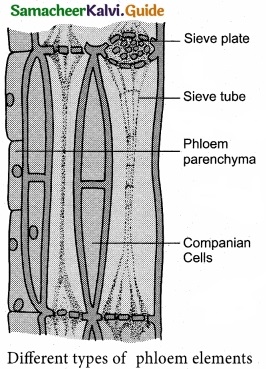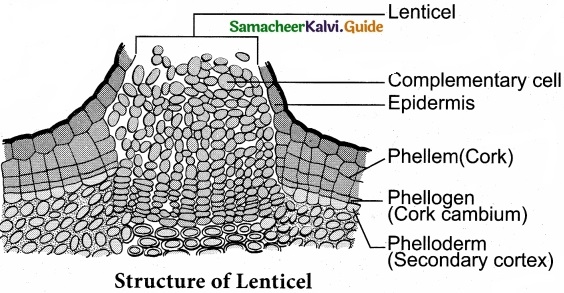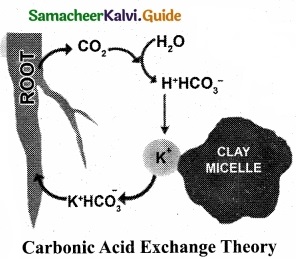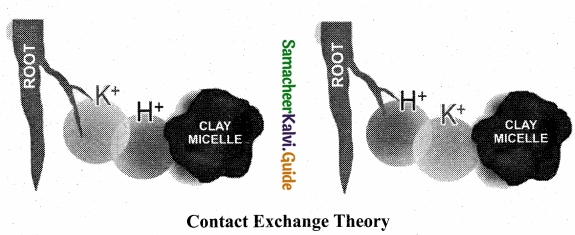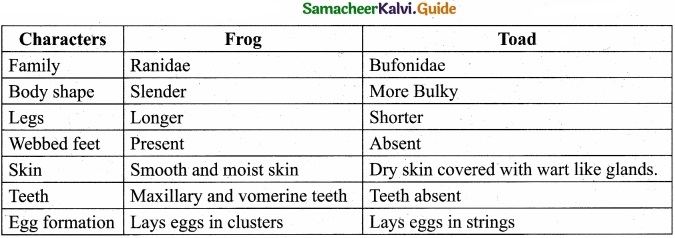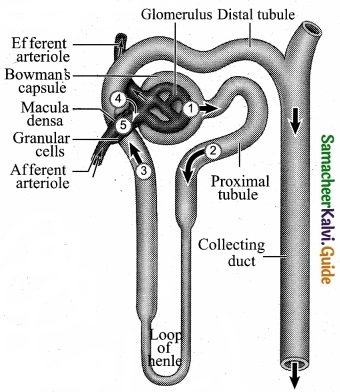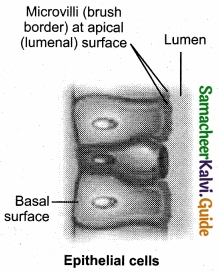Students can Download Tamil Nadu 11th English Model Question Paper 3 Pdf, Tamil Nadu 11th English Model Question Papers helps you to revise the complete Tamilnadu State Board New Syllabus, helps students complete homework assignments and to score high marks in board exams.
TN State Board 11th English Model Question Paper 3
General Instructions:
- The question paper comprises of four parts.
- You are to attempt all the parts. An internal choice of questions is provided wherever applicable.
- All questions of Part I, II, III and IV are to be attempted separately.
- Question numbers 1 to 20 in Part I are Multiple Choice Questions of one mark each.
These are to be answered by choosing the most suitable answer from the given four alternatives and writing the option code and the corresponding answer - Question numbers 21 to 30 in Part II are two-mark questions. These are to be answered in about one or two sentences.
- Question numbers 31 to 40 in Part III are three-mark questions. These are to be answered in above three to five short sentences.
- Question numbers 41 to 47 in Part IV are five-mark questions. These are to be answered in detail Draw diagrams wherever necessary.
Time: 3:00 Hours
Maximum Marks: 90
PART – I
I. Answer all the questions, [20 × 1 = 20]
Choose the correct synonyms for the underlined words from the options given.
Question 1.
I pulled myself together and handed over the card nonchalantly.
(a) indifferently
(b) carefully
(c) cautiously
(d) sentimentally
Answer:
(a) indifferently
Question 2.
The incident is clearly etched in my memory.
(a) erased
(b) melted
(c) imprinted
(d) refrained
Answer:
(c) imprinted
![]()
Question 3.
The libraries are a repository of knowledge.
{a) refractory
(b) refrigerator
(c) storeroom
(d) management
Answer:
(c) storeroom
Choose the correct antonyms for the underlined words from the options given.
Question 4.
It is important that even the mediocre are given due recognition.
(a) middling
(b) ordinary
(c) exceptional
(d) middleman
Answer:
(c) exceptional
Question 5.
I managed to solve the complex problem.
(a) intricate
(b) compound
(c) simple
(d) complicated
Answer:
(c) simple
Question 6.
It is compulsory to donate one day salary for the flood victims.
(a) obligation
(b) optional
(c) obeisance
(d) obstruction
Answer:
(b) optional
Question 7.
Choose the blended form of “hazardous and material”.
(a) hazardmat
(b) hazat
(c) hazmat
(d) mathaz
Answer:
(c) hazmat
![]()
Question 8.
Choose the right definition for the given term “etymology”.
(a) A person perceived to be either uncivilized or primitive
(b) A study about the history and origin of a word
(c) The hutnanistic study of language and literature
(d) The belief that all events in life are predetermined and inevitable
Answer:
(b) A study about the history and origin of a word
Question 9.
Choose the meaning of the idiom ‘A penny for your thoughts’.
(a) Current issues spoken by many people
(b) To worsen an unfavourable situation
(c) Everything about the case
(d) Asking what someone is thinking
Answer:
(d) Asking what someone is thinking
Question 10.
Choose the meaning of the foreign word in the sentence.
Our daughter is going to turn 5 next year, so we’ve been trying to find a good kindergarten for her.
(a) preschool
(b) children’s garden
(c) school material
(d) play school
Answer:
(b) children’s garden
Question 11.
Choose the word from the options given to form a compound word with “while”.
(a) mean
(b) teach
(c) scene
(d) weather
Answer:
(a) mean
Question 12.
Choose the word from the options given to form a compound word with “qualified”.
(a) sur
(b) dis
(c) in
(d) mis
Answer:
(b) dis
![]()
Question 13.
Choose the expanded form of “FTCL”.
(a) Fellow Tribal Colleges of Linguistics
(b) Federal Trinity College of Libya
(c) Fellowship Trinity College of London
(d) Feminine Travellers Chambers of Ladies
Answer:
(c) Fellowship Trinity College of London
Question 14.
Use for dramatic works involving the downfall or destruction of the protagonist due to character flaws, catastrophe, or reversal of fortune.
(a) Comedy
(b) Monologue
(c) Tragedy
(d) Historical Plays
Answer:
(c) Tragedy
Question 15.
A passion for writing is known as ………..
(a) Animator
(b) Graphomania
(c) Sonettomania
(d) Eulogomania
Answer:
(b) Graphomania
Question 16.
Fill in the blank with the suitable preposition.
Latha laughed till the tears ran ……… her cheeks.
(a) down
(b) with
(c) on
(d) in
Answer:
(a) down
Question 17.
Choose the correct sentence pattern.
Reading made him a complete man.
(a) SVOA
(b) SVOC
(c) SVIODO
(d) SVCA
Answer:
(b) SVOC
Question 18.
Substitute the underlined word with the appropriate polite alternative.
Excuse me, driver. My mother needs use the toilet urgently.
(a) comfort stop
(b) nature calls
(c) rest room
(d) powder room
Answer:
(a) comfort stop
Question 19.
Substitute the phrasal verb in the sentence with a single word.
I don’t know where my book is. I have to look for it.
(a) retrieve
(b) look
(c) search
(d) find
Answer:
(c) search
![]()
Question 20.
Fill in the blank with a suitable relative pronoun
They finally found the murderer, ………. was hiding in a small town.
(a) where
(b) which
(c) who
(d) that
Answer:
(c) who
PART – II
II. Answer any seven of the following: [7 × 2 = 14]
(i) Read the following sets of poetic lines and answer any four of the following. [4 × 2 = 8]
Question 21.
“And I have learned too
To laugh with only my teeth
And shake hands without my heart”
(a) Explain ‘To laugh with only my teeth’.
(b) Why is he shaking hands without heart?
Answer:
(a) Laughing with only teeth means laughing without genuine emotions of love, warmth and friendliness. It is fake.
(b) The heart is a symbol of genuine emotions. The poet recalls the time when people used to smile and shake hands with their hearts. Now, things have become different.
Question 22.
“For he’s a fiend in feline shape, a monster of depravity
(a) Identify the poem and the poet.
(b) Explain the phrase ‘monster of depravity’.
Answer:
(a) The poem is ‘Macavity – The Mystery Cat’ written by T.S. Eliot.
(b) Satan is called the master of depravity. T.S. Eliot calls Macavity, the master of depravity. He means that the cat is an embodiment of evil. He is wicked and all the time involved in doing something evil.
Question 23.
“We deem it our duty and mission in life,
To bless and praise the deserving ones;
Never shall we fail in what we commit,
Shall nourish the ones that nourish the world.”
(a) What is the poet’s mission in life?
(b) Explain the last line.
Answer:
(a) The poet’s mission is to identify deserving people with natural talents and appreciate them.
(b) The poet claims that simple people like farmers, teachers and other noble professionals nourish those who nourish the world.
Question 24.
“As if this flesh which walls about our life
Were brass impregnable and, humour’d thus”
(а) What does the king realize?
(b) Explain the phrase ‘brass impregnable’.
Answer:
(a) The king realises that his mortal body also will come to an end like others.
(b) ‘Brass impregnable’ means someone that is unconquerable.
![]()
Question 25.
“I heard a thousand blended notes While in a grove I sate reclined,”
(a) What do you mean by‘blended notes’?
(b) What was the poet doing there?
Answer:
(a) The blended notes mean the combined music of birds which cohabit in the grove.
(b) The poet was relaxed and was listening to the music of the birds.
Question 26.
“My limp and bashful spirit feeds On other people’s heroic deeds”
(a) What does the poet say about his own temperament?
(b) How does the poet feed his love for games?
Answer:
(a) The poet agrees that he is weak, shy and reluctant.
(b) He derives vicarious pleasure watching others play heroically on the sports field.
(ii) Do as Directed: (Answer any three) [3 x 2 = 6]
Question 27.
Report the following dialogue:
Shilo : How are you Cathy? Please check mail regarding your travel arrangements to Muscat.
Cathy : Could you please send it again since I haven’t received any mail from you.
Answer:
Shilo asked Cathy how she was and to check mail regarding her travel arrangements to Muscat. Cathy requested Shilo to send it again as she hasn’t received any mail from him.
Question 28.
Change into active voice of the following sentence.
The work can be done by Shanthini.
Answer:
Shanthini can do the work.
Question 29.
Rewrite the sentence making an inversion in the conditional clause.
If we’d bought that property, we would have been rich by now.
Answer:
Had we bought that property, we would have been rich by now.
Question 30.
The firefighters made several attempts. They could not save the drowning cub. (Change into a simple sentence)
Answer:
In spite of making several attempts, the firefighters could not save the drowning cub.
PART – III
III. Answer any seven of the following: [7 × 3 = 21]
(i) Explain any two of the following with Reference to the Context: [2 × 3 = 6]
Question 31.
They do not ever in their dealings
Consider one another’s feelings…
Answer:
Reference: The poet Ogden Nash says these words in the poem “Confession of a Bom Spectator’.
Context: The poet says these words, while highlighting the callous indifference of players to the pain and injuries of fellow players.
Explanation: Every player considers the player in the opposite team as a deadly rival. He looks for an opportunity. We do find hockey players hitting good players on the ankle with the stick to prevent them from playing great shots. Bowlers try to hit the body of batsman with the ball. They don’t seem to notice cracking wrists and snapping knees as their focus is only on victory and glory. In short, the players do not have feelings for the fellow players.
![]()
Question 32.
The birds around me hopp’d and play ’d,
Their thoughts I cannot measure.
Answer:
Reference: These lines are from the poem “Lines’Written in Early Spring” written by William Wordsworth.
Context: The poet was quite impressed with the beauty and peace that prevailed in the woodland. The birds were oblivious to the presence of the poet. They hopped and chirped around him in absolute bliss. The poet said these words while trying to fathom their thoughts.
Explanation: The poet was overwhelmed with delight in the company of birds, plant kingdom and the brook. He tried hard to understand the thoughts of the birds through the bird’s language. But he couldn’t succeed. He simply inferred that they were thrilled and enjoying the jocund company.
Question 33.
He’s the bafflement of Scotland Yard, the Flying Squad’s despair:
Answer:
Reference: These words are from the poem, “ Macavity – the mystery cat, written by T.S., Eliot.
Context: The poet says these words while describing the criminal activities and how he eludes the detection by Scotland Yard Police.
Explanation: Scotland Yard Police is known world over for quick disposal of criminal cases. But Macavity is such a criminal that the Scotland Yard policemen are unable to produce evidence to arrest him. So, they are baffled. The flying squad is unable to pursue him soon after the crime is committed. So, they are desperate to nab him.
(ii) Answer any two of the following briefly: {2 × 3 = 6]
Question 34.
What does the author mean when he says the letter in his pocket leads an unadventurous life?
Answer:
The poet forgets the letters kept in his pocket. Whenever the friend enquires about the unposted letters, it embarrasses him. then he is forced to produce the evidence of his guilt (i.e.,) the unposted letters. This awkward humiliation is said to be unadventurous.
Question 35.
What is a tight corner? What happens when one finds oneself in a tight corner?
Answer:
Tight comer is a difficult situation. When one finds oneself in a tight comer, one worries and thinks seriously about the ways of getting out of it.
Question 36.
Why did the author’s concern over tobacco shift to his finger?
Answer:
When the author saw the racing tobacco box disgorging its content, he worried about the need to buy expensive tobacco in England. But when he saw his own bleeding finger that he had gashed while forcefully opening the jammed zip, he shifted his cry to his finger.
![]()
(iii) Answer any three of the following: [3 × 3 = 9]
Question 37.
Study the pie-chart and answer the questions that follow:
The factors which affect health are given percentage-wise in the pie-chart.
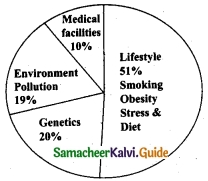
Questions
- What percent of diseases are caused due to pollution?
- Fifty one percent of illnesses are caused by what factors?
- What is the least percent of health affected by?
Answer:
- Nineteen percent of diseases are caused due to pollution.
- Fifty one percent of the causes of illness is jointly shared by lifestyle, smoking, obesity, stress and diet.
- Lack of medical facilities.
Question 38.
Build a dialogue of minimum three exchanges between bank manager and a student who wants to open a bank account.
Answer:
Vanin : Sir, I want to open a savings account.
Bank Manager : Have you brought your aadhar card and two copies of photograph?
Varun : Yes, sir.
Bank Manager : Fill in this application and the challan and pay the initial amount in the 3rd counter.
Varun : Sir, the pass book.
Bank Manager : You can collect it tomorrow evening.
Varun : Thank you sir.
Question 39.
Describe the process of pitching a tent.
Answer:
Select a location free of debris and an area that is as level as possible for your campsite.
Lay down your footprint or ground cloth.
Position the tent over the footprint with the doors facing away from the wind for the best ventilation.
Lay out the poles and assemble them.
Insert the tent poles and secure it to take up the tension in the poles.
Pull the tent upright.
Question 40.
Complete the proverbs choosing the suitable words given in brackets.
- Don’t blow your own ……….. (horn, trumpet, whistle)
- Early ………. catches the worm, (man, hen, bird)
- Empty bags cannot ………. upright, (stand, sit, lie)
Answer:
- trumpet
- bird
- stand
PART – IV
IV. Answer the following: [7 × 5 = 35]
Question 41.
Why was Mary Kom named the “Queen of Boxing”?
Answer:
After Mary Korn’s first silver medal in Pennsylvania in 2001, there was no looking back. Her medal haul continued even after her marriage putting an end to the speculation of family and friends that her marriage may slow down her career progression. She retained the world title in the third World Women’s Boxing Championship at Podolsk in Russia in 2005. She won her fourth gold also in 2006. She had won several golds for India from 2001 to 2004. She had won all the Senior Women’s Boxing Championships, Second Women’s Championship (2002), Second Asian Women’s Boxing Championship at Hisar (2003) and the Witch Cup Boxing Championship at Paes, Hungary.
There were a number of other International World Championships in Taiwan, Vietnam, Denmark and so on. But it was retaining her World title in 2006 by defeating Steluta Duta of Romania which was considered as Mary Korn’s greatest achievement in life. With this hat-trick of World Championship wins, the media has rightly christened her, “Queen of Boxing”.
![]()
[OR]
Bill Bryson “ached to be suave”. Was he, successful in his mission? If not what are the reasons.
Answer:
Bill Bryson expresses his genuine desire to be “suave”. He would love just once in his life time to rise from the dinner table as if he had not experienced an “extremely localized seismic event, get into a car without leaving 14 inch coat outride, wear light-coloured trousers without ever discovering at the end of the day that he had at various times and places sat on chewing gum, ice-cream cough syrup and motor oil. No, Bill Bryson was not successful in his mission.
Twice he spilled his drinks on a sweet nun who happened to sit next to him. He tried to show off his wisdom to another attractive lady. As usual, he was sucking his pep. His shirt, teeth and gum carried the unscrubbable navy blue stain for many days. He always did “liquid mischief’. His clumsy behaviour in the aeroplane made the saintly nun use abusive language. To avoid unsuave ways, he gave up air-travel with his family members. His wife and children supported him yet failed to refine his manners.
Question 42.
How is it true that Macavity is indeed a mystery cat?
Answer:
Macavity is an elusive master criminal who leaves no evidence after he commits a crime. He baffles Scotland Yard police and the flying squad as he disappears before their arrival to the scene of crime. He is called a “Hidden paw“ because even Scotland Yard is unable to arrest him after he commits any crime. He does not leave his foot prints in the spot of crime. He defies law of gravity and his powers of levitation make the fakir stare with wonder.
Other cats are lazy and just stay in the kitchen and take the food offered by their master. But Macavity is agile and defies law of the land and laws of gravity. Despite doing all wicked things, he pretends to be innocent. So, the poet claims one can never come across such a cat of “Deceitfulness and suavity”. When he appears to be half-asleep with his half-closed eyes, he would be wide-awake. He is an enigma to everyone. Macavity is indeed a mystery.
[OR]
Trace the confessions of a born Spectator as listed out by Ogden Nash.
Answer:
This poem is about a bom spectator who confesses about his views on Sports and sportsmen. He says that they injure each other as they prance and feel happy on others heroic deeds. His limp and bashful spirit feeds on the heroism of other players. He has seen zealous athletes playing so rough that they never consider the feelings of fellow players. He watches with a palpitating heart when ‘A’ runs ninety yards to bag a medal. He watches with obvious alarm when ‘B’ knocks another boxer down cracking his vertebrae and spines.
They.are insensitive to the cracking wrist and snapping knees of fellow players. When his ego and prudence clashed, ego told him to seek glory in sports, but his prudence always ignored it. Thus common sense prevailed, he remained a cheerful life-time fan of successful athletes. He was contented as a spectator of all kinds of games and sports and world famous athletes. The crazy desire for championship titles and the light of fame on them leads them to ignore swollen eyes, snapping of knee joints or cracking of wrists.
![]()
Question 43.
Write a paragraph (150 words) by developing the following hints
“After Twenty Years,” – time -10 o’clock at night – depeopled the streets – only two men – on street – that night – policeman approaches – lurking man – light from his match – shows a pale face – keen eyes, a scar in eyebrow – a scarf pin – diamond – expensive watch – all hints as to the man’s past.
Answer:
The short story “After Twenty Years” takes place around 10 p.m. along a dark, windy New York City business avenue, mostly within the darkened doorway of a closed hardware store. This particular location had been a restaurant until five years ago. The plot begins with a policeman “on the beat” who discovers a man standing in the dark doorway. The man then proceeds to explain why he is there. He and his best friend, Jimmy Wells had parted exactly twenty years ago to make their fortunes and had promised to meet at that spot “After Twenty Years”. He had gone west and gotten rich and was sure his friend, Jimmy would meet him if he were alive. They talked a while and the policeman carried on. The man from the west wonders if his friend will come.
The drama increases in anticipation of the rendezvous. Twenty minutes later, another man, whom we assume is his long lost friend, greets him warmly and they walk arm in arm discussing careers until they come to a well-lit comer near a drug store. The man from the west gets a good look at his companion and discovers that he is not his friend, Jimmy. We are treated to several surprises for the man from the west is under arrest and secondly he is actually ‘Silky Bob’, a gangster from Chicago and finally the stranger is a plainclothes policeman. However, it seems that these three surprises are not enough. We get the “real” surprise when Jimmy Wells, the original policeman didn’t have the heart to arrest Bob, because he was his friend.
[OR]
Philip – travels – train – Brill Manor – meets Bertie – second son – left purse – four quids – needs money – requests Philip to lend him – two pounds -did not help – true . son – mistaken for a fraud.
Answer:
The young man who entered the coach gave out a smothered curse, he was engaged in searching something elusive angrily and uselessly. From time to time, he dug a six penny bit out of a waist coat pocket and stared at it sadly, then resumed his search. He voluntarily broke the silence. He exclaimed that Mr. Sletherby was going to Bill Manor. He introduced himself as Bertie, the younger son of Mrs. Saltpen-Jago. He admitted that he was away for about six months and had not seen his own mother.
Making use of the lucky coincidence that he was going to Brill Manor, he asked for a loan of three pounds as he had lost his sovereign purse and was desperately in need of help. He promised to meet him on the subsequent Monday. There is a dramatic irony when the son himself gives a different version of his mom’s appearance. This influences the decision of Mr. Sletherby in refusing to lend Bertie a loan of three pounds and mistaking the true son Bertie to be a fraud.
![]()
Question 44.
Write a summary or make notes of the following passage.
The word procrastination comes from two Latin terms meaning to ‘put forward until tomorrow’. Standard dictionary definitions include the idea of postponement or delay. Steel, a psychologist who has reviewed hundreds of studies on the subject, states that to procrastinate is “to voluntarily delay an intended course of action despite expecting to be worse-off for the delay”.
Another expert, Dr. Joseph R. Ferrari, distinguishes between people who tend to put things off and “chronic” or “real” procrastinators for whom this is their life and who might even need therapy. Ferrari categorizes procrastinators into three types: (a) stimulation types that get a thrill from beating a deadline, (b) avoiders put off doing things that might make others think badly of them, and (c) decisional procrastinators who postpone making a decision until they have enough information to avoid making a wrong choice.
Chronic procrastinators tend to have low self-esteem and focus on the past more than the future. The Discounted Expectancy Theory illustrates with a student like Sam who puts off writing a paper. When the deadline is far off, the rewards for socializing now are greater than those for finishing a task not due until later. As the deadline looms, the rewards or consequences for finishing the paper becomes more important.
Tice and Baumeister found that procrastinators on the average got lower grades and had higher levels of stress and illness. Chu and Choi however, say that not all procrastinators are lazy and undisciplined. “Passive procrastinators” are more stressed and so less efficient. “Active procrastinators prefer to work under pressure” and “if something unexpectedly comes up, they will knowingly switch gears and engage in new tasks they perceive as more urgent.”
Answer:
Summary
No. of words given in the original passage: 280
No. of words to be written in the summary: 280/3 = 93 ± 5
Rough Draft
procrastination is a Latin word. Hundreds of studies reviewed by Steel, a psychologist states that to procrasinate is “to voluntarily delay an intended course of action despite expecting to be worse-off for the delay”. Another expert Dr. Joseph R. Ferrari, distinguishes between “chronic” or “real” procrastinators into three types: stimulation types avoiders and decisional procrastinators. Chronic procrastinators self-esteem.
Tice and Baumeister found that procrastinators get lower grades and have higher levels of stress. Chu and Choi, say that “Passive procrastinators” are more stressed and so less efficient. “Active procrastinators prefer to work under pressure” and “if something unexpectedly comes up, they will knowingly switch gears and engage in new tasks they perceive as more urgent.
Fair Draft
Procrastination
Procrastination is a Latin word. Hundreds of studies reviewed by Steel, a psychologist states that to procrastinate is “to voluntarily delay an intended course of action despite expecting to be worse-off for the delay”. Another expert, Dr. Joseph R. Ferrari, distinguishes between “chronic” or “real” procrastinators. Ferrari categorizes procrastinators into three types: stimulation types avoiders and decisional procrastinators. Chronic procrastinators have low self-esteem.
Tice and Baumeister found that procrastinators get lower grades and are stressed. Chu and Choi, say that “Passive procrastinators” are more stressed and less efficient. “Active procrastinators” work under pressure and if something more urgent comes up they change their focus.
No. of words in the summary: 104
![]()
[OR]
Note-making
Title: Procrastination
Answer:
1. Intro A proctn
Origin – Latin
Meaning – Put fwd till tomorrow – Idea A postponement or delay Steel (psychologist) – voluntary delay – despite expecting to be worse-off
2. Categorn
a. Dr. Joseph R. Ferrari
Stimln types – thrill 4m beating a deadline
Avoiders – avoid things // make others think badly A them
Decisional – postpone making a decsn (until enough information)
Real procs – way A life (might need therapy)
Chronic procs:
Low self esteem
Focus on past
b. Tice and Baumeister
Procs got lower grades
Higher levels A stress and illness
c. Chu and Choi
Passive procs – stressed, less efficient
Active procs – prefer to work under pressure, knowingly engage in new tasks
Conclusion: The word procrastination comes from two Latin terms meaning to ‘put forward until tomorrow’.
Abbreviations: Intro – Introduction; A – of; Proctn – procrastination; Fwd – forward; Stimln – stimulation; Categorn – categorization; 4m – from; // – that; decsn – decision; procs – procrastinators
Question 45.
Write a letter to the Editor of a famous daily, Dindigul about the incidents of violence taking place with the aged living alone at home, drawing the attention of authorities towards the problem.
Answer:
22nd July 2020
From
Vinitha
Railway Colony
Dindigul
To
The Editor
Daily Thanthi
Dindigul
Respected Sir,
Sub: Violence against the aged living alone at home.
I wish to draw your attention towards the security of the aged people living alone at home in Dindigul. Almost every day we find the newspapers full of such incidents. The miscreants rob the people and then murder them. Many times the servants of the house are found involved in these incidents. The aged are the gullible people and are easily made target.
I hope after publishing this letter in your esteemed newspaper, the police will take some necessaiy actions for their safety.
Thanking you
Yours faithfully,
Vinitha
Address on the Envelope
To
The Editor
Indian Express
Chennai
![]()
[OR]
Write an essay in about 150 words on ‘Where there is a will, there is a way.’
Answer:
Where there is a will, there is a way
Where there is a will, there is a way is an old saying in English which teaches us about the most significant subject of getting success in life. Reaching a nice target becomes our maxim. However achieving a target needs strong determination and commitment. People without having will power never achieve the victory and they curse their destiny. This common saying simply means that if the person is strong-minded enough to get something done, he/ she always will find a way to do that. Fortitude is necessary to get completion in the task as it helps a person to fight with all difficulties and get success.
Without grit and will power, we generally tend to give up very easily in the initial stages as we become desperate facing small teething issues. To learn or achieve something in life, will power acts as a channel and enhances the speed of action. It needs a firm and incessant exercise to deeply learn things. We can pass the exam by reading the lessons just a night before the exam. However, we cannot be ranked first in the class, district or state without hard work for the entire year. One needs to be systematic, meticulous and focused to with a strong will power to pave way for success. So, it is good to have determination even to the smallest tasks in life and never yield to petty things easily.
Question 46.
Read the following sentences, spot the errors and rewrite the sentences correctly.
(a) He was tall and thin and has giant features.
(b) The stories he read are all about adventure.
(c) In general mass media means various ways communication.
(d) This is due the various advancements and achievements in the field of communication.
(e) Mohan Das Karamchand Gandhi go to England for higher studies at the age of 19.
Answer:
(a) He was tall and thin and had giant features.
(b) The stories he read were all about adventure.
(c) In general mass media means various ways of communication.
(d) This is due to the various advancements and achievements in the field of communication.
(e) Mohan Das Karamchand Gandhi went to England for higher studies at the age of 19.
[OR]
Fill in the blanks appropriately.
(a) I can ………. the bell from ……… (hear/here)
(b) I ………. swim quite well when I was younger. (Fill in with a modal verb)
(c) She ……….. spend more time for practice, (use semi-modal)
(d) England lost their test match against India ………… over confidence and less preparation. (Use a suitable link word)
Answer:
(a) hear, here
(b) could
(c) ought to
(d) due to
![]()
Question 47.
Identify each of the following sentences with the fields given below.
(a) As in January 2005, the rate of inflation came down to 3%.
(b) At the international level, global warming Has increased the anxiety of many nations.
(c) A new rocket launching station is commissioned in Andhra Pradesh.
(d) Your monitor is not working. Get it repaired.
(e) Mr. Venkatraghavan is one of the best umpires in the world.
(Science, Computer, Sports, Commerce, Environment)
Answer:
(a) Commerce
(b) Environriient
(c) Science
(d) Computer
(e) Sports
[OR]
Read the following passage carefully and answer the questions that follow.
Today we don’t think of a cartoon as being associated with great art, but at one time it was. During the period of Italian Renaissance, the term ‘cartoon’ meant the first sketch in actual size of a large work of art, such as a mural (wall painting). When newspapers and magazines began to use drawings to illustrate news and editorial opinion and to provide amusement, these drawings came to be known as cartoons. In the days before the newspaper, artists like Hogarth, Daumier and Rawlandson made a series of drawings on a single theme. Sometimes such a series of drawings pictured and adventures of a single character. They were the ancestors of present-day cartoons and comic strips.
In the nineteen and early twentieth centuries, there were a number of magazines which specialised in cartoons. In Paris there was one called ‘Charivari’ and in London there was the famous ‘Punch’. Nowadays movies based on cartoons characters are also made. Movies featuring Tom and Jerry, Dennis the Menace, Tarzen, Mickey Mouse and Donald Duck are very popular with children.
Questions.
- Identify the purposes for which cartoons were used in newspapers.
- In what sense did the Italians use the term ‘cartoon’ during the Renaissance period?
- Who were the ancestors of present-day cartoons and comic strips?
- Name the two magazines mentioned in the passage which specialised in cartoons.
- Name the famous cartoon character you are familiar with.
Answer:
- Cartoons were associated with great art. It is a large work of art.
- During the Renaissance period the term ‘cartoon’ was used to mean first sketch of a large work of art.
- Artists like Hogarth, Daumier and Rawlandson were the ancestors of the present-day cartoon and comic strips.
- Charivari and punch were the two magazines which specialised in cartoons.
- Mickey mouse and Donald Duck are the famous cartoon characters I am familiar with.
![]()
